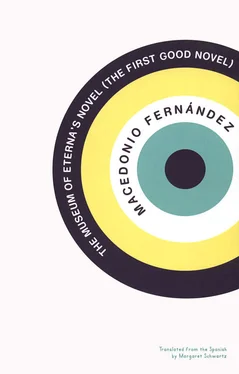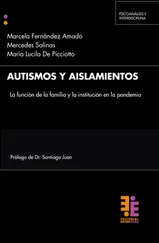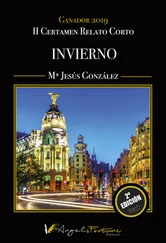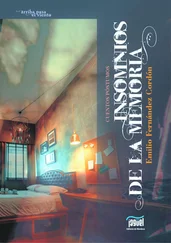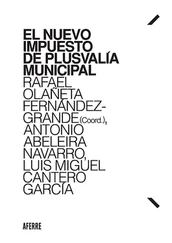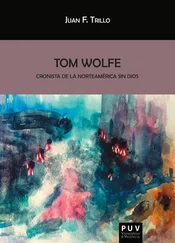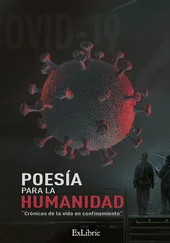Space is unreal, the world has no magnitude, given that what we can encounter with our widest gaze, the plains and the sky, fit in Our memories, that is, in an image. They fit totally and in all their detail in a point of my psyche, of my mind; this does not have extension, points, and it contains images. It’s sufficient that the material can make an image of itself without a position or extension, when I invoke it in my mind — it can represent itself totally and exactly, it can see itself (since only by this concept are we able to say that in this case we aren’t seeing, but recalling) and the proof is the fact that in a dream, or in a waking evocation that is very intense, the image is equally alive and gives rise to the same emotions, acts, words, and gestures. Thus it is shown that 1) the Exterior is not intrinsically extensive; 2) the mind, psyche, consciousness, soul, sensibility — all essentially synonyms for subjectivity — has no extension, position, or station anywhere; 3) that immensity, the Cosmos, is therefore a point, or better, the autonomous, involuntary Image, the contingent and spontaneous that we face with our will.
In other words, everything that exists is an image, some voluntary, others involuntary, dreams and reality intermingling and giving rise to the same emotions and acts when they are equally vivid.
Given all this, it may therefore be said that the world is inextensive. But sometimes an object presents a different size, depending on the position it takes relative to ourselves; the sounds emanating from it with an identical rhythm would vary in their intensity, and to get a different kind of feeling from it, a tactile feeling, we’d have to effect some kind of translation. We thus have the only thing that’s effective about Space: the effect. Distance, or given the perception of an object, sound, or perfume, we can make the size, the detail, or the intensity larger depending on the case and by means of our own work, which we would call getting closer, and in a certain moment of this task we could obtain a tactile sensation from this visual object. That translation is required, so that an object that we call distance can offer us a tactile sensation, is an effect of “space” and its only reality.
Likewise, with regard to Time, its reality resides in its effect, that a waiting is required, which is to say a series of events, so that there is a desired or feared outcome after one of those changes or states of things which we call the present, When something pleasurable is desired, it’s in the future ; if pain is feared, it’s the future also; if something painful is not feared, it’s past, and the same for the pleasurable if it does not give rise to desire or joy; in each case there’s always present effects of the past or present states that would be in the future. A student, who is two or three months away from his exams might have alternative representations of the same scene: imagining himself in some classroom near a table where four professors are seated; this scene could correspond, with the same details, to the anatomy exam he sat for in March or the one coming up next November: Which one of these scenes is future, or past? The intellectual fringe is exactly the same: sometimes it gives rise to a feeling of fear, and sometimes a pleasant feeling. In the first case the event is future; in the second it’s past: the exam that I passed is pleasant for me to recall, the one I am about to take intimidates me.
Size (space) and duration (time) are not real, but inferences with respect to the effect of the muscular work of transposition or the mental work of hope, uncertainty, desire. Duration is merely the sum of the changes that must occur, that make themselves actual before another change happens; and this before and this make itself actual are not temporal implications, which would be tautological in this case, but psychological correlatives: so the actual is a state when the feeling — fear or desire — which is tied to it culminates in insensibility: the fear of something as fear is naturally always actual or present, but the represented or perceived scene is only real when the fear reaches its limit.
I’ve said all this to establish the nothingness of Time and Space. These are abstractions which only can tell us what happens in terms of representations of scenes or events which in perception or reality bring us pain or pleasure and which nevertheless are given in our minds several times, sometimes giving rise to emotion and drives and sometimes not. (In the first case the image is of a future reality;
in the second, of a past reality.) Such is the case with all that happens in our psyche with respect to Time. Distant and proximal (Space), in its turn, are differentiated because of the possibility of obtaining a better view of some object, or of other sensations of it, and in some cases, this demands a kind of work of translation: I see a flower and in order to obtain from it a tactile sensation and the sensation of aroma, I must initiate a muscular action, or another person must do it for me. This is all that matters about Space.
The nothingness of Time and Space, which is correlative to the nothingness of the Self (or personal identity) and of material Substance, situates us in an eternity without conceivable discontinuities. This is the metaphysical certainty of my novel.
1 This metaphysical doctrine is stated principally in No toda es Vigilia la de los Ojos Abiertos y Otros escritos (Not all Consciousness is Wakefulness and Other Writings) (Editor’s Note — Adolfo de Obieta)
THE MAN WHO FEIGNED TO LIVE (THE ONLY CHARACTER WHO NEEDS EXPLAINING. HE’S ALREADY BEEN EXPLAINED TWICE: 1 HE LACKS EXISTENCE, BUT HE ABOUNDS IN CLARIFICATIONS.)
1 It could be that I’ll only give him two explanations, though I’ve promised two. Yet another inconsistency! But I already said, or I’ll say so later on, that I use any recourse, including inconsistencies, to confront the artistic or verisimilitude, childish verisimilitude, and I will signal each recourse and justify them all. It’s a more frank way of proceeding and a great labor that I undertake on the public’s behalf, much greater than the comfortable and overdone practice of putting lunatics in novels. Quixote, Sancho, Hamlet, these are all characters who are admittedly insane, like Dostoevsky’s idiot, and one of Hamsun’s protagonists (they awarded a madman to this writer, if during a single page he behaves with any sort of logic he doesn’t get the crazy man and we say that the author has failed: the lunatic gains the author an exemption from taking care with his absurdities). And nevertheless these authors continue to believe that they are realists; to make a novel or a play with lunatics in it is like doing science by negating causality, it’s to opt for as little work as possible since everything is explained by dementia, as if it were the novel’s coordinator, which makes realism impossible to verify for the reader, since the disjointed and absurd are in fact a verisimilitude of dementia. Insanity in art is a realist negation of realist art. The effects, consequences, and influences of insanity for the sane characters might be realist art, but the conduct and character of the lunatic character, which is what principally happens in these comfortable, pseudorealist novels, amounts to an outrageous practical joke. Analogously the sensory (the pleasures and pains of eating, smoking, of sexuality and physiology, etc) is not a possible topic for art; the effects of sensuality on the non-sensuality of a character, yes. Example: Bovary, whose life is entirely despicable for its sensual despair, which does not interest art except as desperation, not sensuality. I don’t give you insane characters, I give an insane book, and with the precise goal of persuading by artistic, not realist means.
Читать дальше
